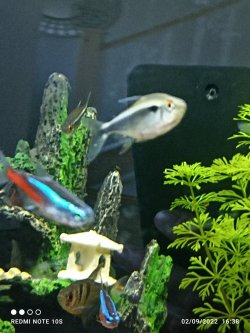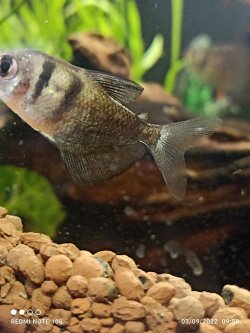You are using an out of date browser. It may not display this or other websites correctly.
You should upgrade or use an alternative browser.
You should upgrade or use an alternative browser.
White spot on fish.What is that please.Is that illness??
- Thread starter Adriana
- Start date
Is there any way you could take some clearer pictures? Not sure if what I see in the second picture is blur or white spot.
Adriana
New Member
Yes I will try my best.Just is not easy.Is there any way you could take some clearer pictures? Not sure if what I see in the second picture is blur or white spot.
Attachments
it looks like excess mucous on a couple of bites for the neon tetra.
the black widow/ skirt tetra could have a white spot on the tail but it is also in poor condition and may have underlying health issues.
--------------
Check the water quality for ammonia, nitrite, nitrate and pH
Do a 75% water change and gravel clean the substrate every day for a week and see how they go.
Make sure any new water is free of chlorine/ chloramine before it's added to the tank.
the black widow/ skirt tetra could have a white spot on the tail but it is also in poor condition and may have underlying health issues.
--------------
Check the water quality for ammonia, nitrite, nitrate and pH
Do a 75% water change and gravel clean the substrate every day for a week and see how they go.
Make sure any new water is free of chlorine/ chloramine before it's added to the tank.
Adriana
New Member
Do a water change and gravel clean, and monitor the fish. If they get more white dots, then post more pictures. Same deal if it gets worse on the neon, post more pictures.
If you want to add some salt you can, then see if it improves. If it doesn't improve after a week, stop using the salt.
----------------------
SALT
You can add rock salt (often sold as aquarium salt) or swimming pool salt to the aquarium at the dose rate of 1 heaped tablespoon per 20 litres of water. If there is no improvement after 48 hours you can double that dose rate so there is 2 heaped tablespoons of salt per 20 litres.
Keep the salt level like this for at least 2 weeks but no longer than 4 weeks otherwise kidney damage can occur. Kidney damage is more likely to occur in fish from soft water (tetras, Corydoras, angelfish, Bettas & gouramis, loaches) that are exposed to high levels of salt for an extended period of time, and is not an issue with livebearers, rainbowfish or other salt tolerant species.
The salt will not affect the beneficial filter bacteria, fish, plants, shrimp or snails.
After you use salt and the fish have recovered, you do a 10% water change each day for a week using only fresh water that has been dechlorinated. Then do a 20% water change each day for a week. Then you can do bigger water changes after that. This dilutes the salt out of the tank slowly so it doesn't harm the fish.
If you do water changes while using salt, you need to treat the new water with salt before adding it to the tank. This will keep the salt level stable in the tank and minimise stress on the fish.
When you first add salt, add the salt to a small bucket of tank water and dissolve the salt. Then slowly pour the salt water into the tank near the filter outlet. Add the salt over a couple of minutes.
If you want to add some salt you can, then see if it improves. If it doesn't improve after a week, stop using the salt.
----------------------
SALT
You can add rock salt (often sold as aquarium salt) or swimming pool salt to the aquarium at the dose rate of 1 heaped tablespoon per 20 litres of water. If there is no improvement after 48 hours you can double that dose rate so there is 2 heaped tablespoons of salt per 20 litres.
Keep the salt level like this for at least 2 weeks but no longer than 4 weeks otherwise kidney damage can occur. Kidney damage is more likely to occur in fish from soft water (tetras, Corydoras, angelfish, Bettas & gouramis, loaches) that are exposed to high levels of salt for an extended period of time, and is not an issue with livebearers, rainbowfish or other salt tolerant species.
The salt will not affect the beneficial filter bacteria, fish, plants, shrimp or snails.
After you use salt and the fish have recovered, you do a 10% water change each day for a week using only fresh water that has been dechlorinated. Then do a 20% water change each day for a week. Then you can do bigger water changes after that. This dilutes the salt out of the tank slowly so it doesn't harm the fish.
If you do water changes while using salt, you need to treat the new water with salt before adding it to the tank. This will keep the salt level stable in the tank and minimise stress on the fish.
When you first add salt, add the salt to a small bucket of tank water and dissolve the salt. Then slowly pour the salt water into the tank near the filter outlet. Add the salt over a couple of minutes.
Similar threads
- Replies
- 1
- Views
- 147




